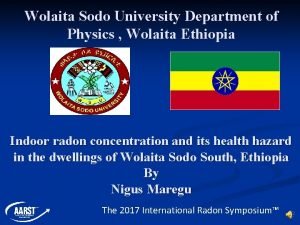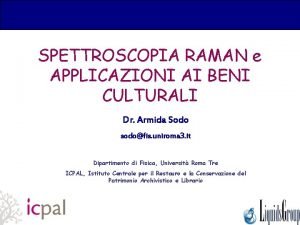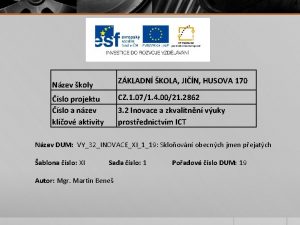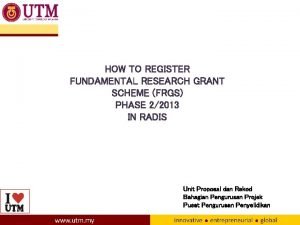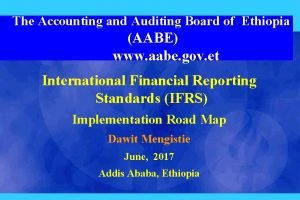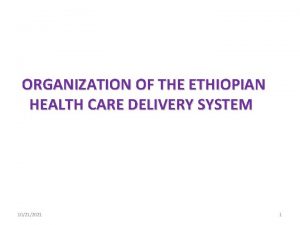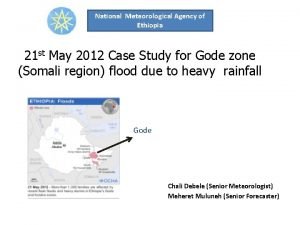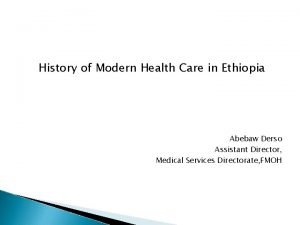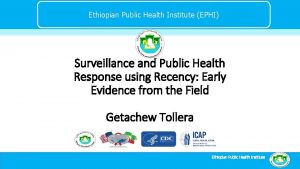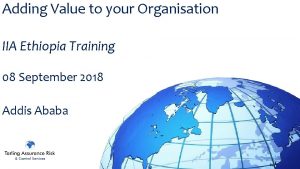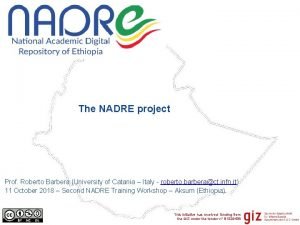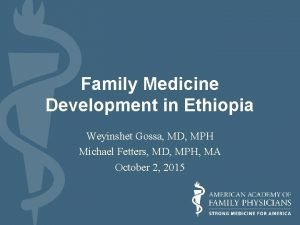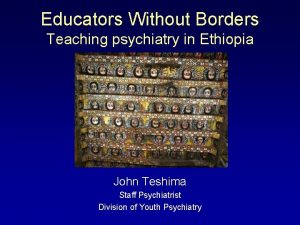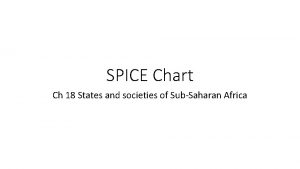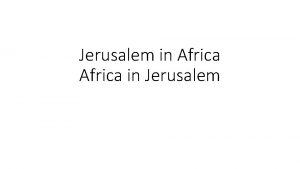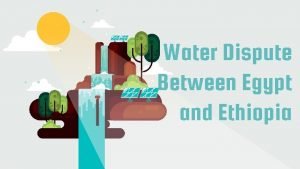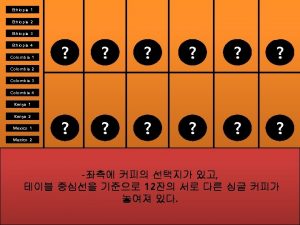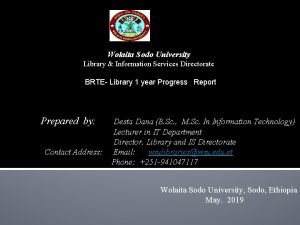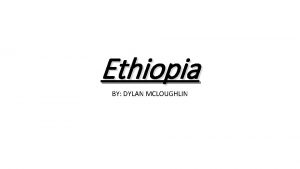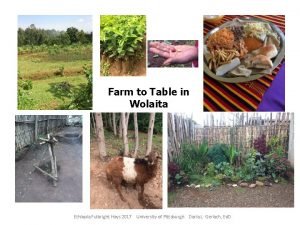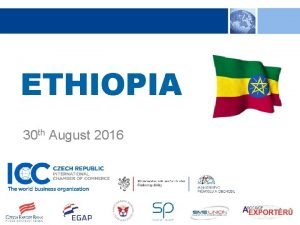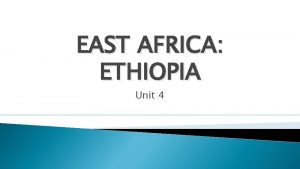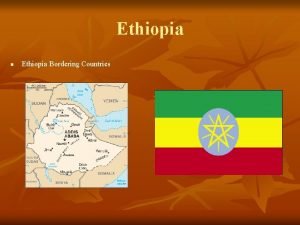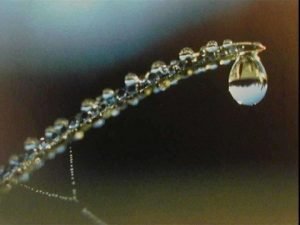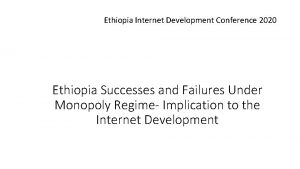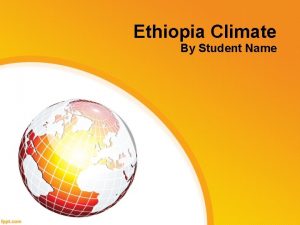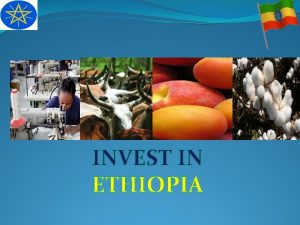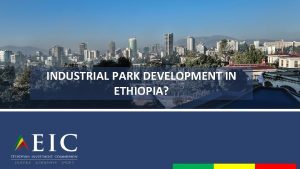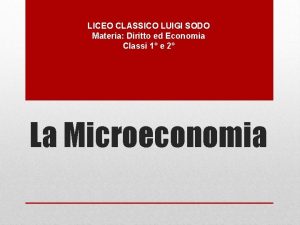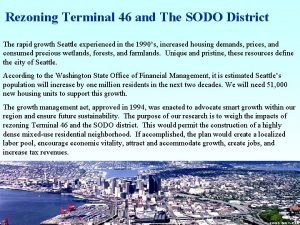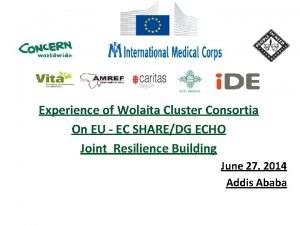Wolaita Sodo University Department of Physics Wolaita Ethiopia





















- Slides: 21

Wolaita Sodo University Department of Physics , Wolaita Ethiopia Indoor radon concentration and its health hazard in the dwellings of Wolaita Sodo South, Ethiopia By Nigus Maregu The 2017 International Radon Symposium™

Outline n Introduction n Objective n Materials and Methods n Result and Discussion n Conclusion

Introduction The risks to human health posed by ionizing radiation are well known. n Radon gas is by far the most important source of ionizing radiation among those that are of natural origin. n It is a gas formed from radium (226 Ra), which is a decay product of Uranium (238 U), emanates from rocks and soils and tends to concentrate in enclosed spaces like underground mines or houses. n The 2017 International Radon Symposium™

Introduction Cont’d… It is a major contributor to the ionizing radiation dose received by the general population. n Radon is a heaviest natural radioactive gas without odor, color or taste. n About 90% of average radiation dose received by human from natural sources and about 50% is due to inhalation of radon, thoron and their progeny present in the dwellings. n The 2017 International Radon Symposium™

Introduction Cont’d… light colored volcanic rocks, granites, dark shale, sedimentary rocks that contain phosphate, and metamorphic rocks derived from those rocks are exist in the study area. The area under investigation were near the Ethiopian rift. n The motivation of our study is to know the possible health risk assessment due to radon, and their short lived decay products in inhalation. n The 2017 International Radon Symposium™

Objectives General Objective v To investigate indoor radon concentration and its health hazard in the dwellings of Wolaita Sodo South, Ethiopia n Specific Objectives v To find out radon gas concentration v To determine dose rate of radon gas v To estimate effective life time cancer risk v To determine alpha particle index n

Significance Used to know the hazards of radon gas n Used to protect ourselves from radon gas n Important for policy makers n Important for researchers for further study n

Limitation Budget constraint n Lack of materials n Lack of cooperation n

The study area The 2017 International Radon Symposium™

Material and Methods The study of indoor radon was carried out in 24 dwellings, at Wolaita Sodo town, Ethiopia. n Using alpha spectroscopy detection method with the help of Corentium digital radon detector in the “Bare” mode. n The 2017 International Radon Symposium™

Material and Methods Cont’d… The detector can record the tracks of alpha particles emitted by radon and its short-lived decay products present in the ambient air. n All the data taken by the detector were analyzed by using different mathematical equations. n The 2017 International Radon Symposium™

Material and Methods Cont’d… n The inhalation dose was calculated in (m. Sv. y− 1) using the relation. The excess lifetime cancer risk (ELCR) due to radon is: Alpha index is calculated as The 2017 International Radon Symposium™

Result Sample No. Indoor radon Concentration (CRn) Inhaled Dose rate (Din) Excess Lifetime Cancer Risk (ELCR) Alpha index 1 81. 74 0. 63 1. 40 0. 41 2 116. 64 0. 90 2. 00 0. 58 3 81. 74 0. 63 1. 40 0. 41 4 108. 37 0. 84 1. 86 0. 54 5 581. 78 4. 49 9. 97 2. 91 6 82. 84 0. 64 1. 42 0. 41 7 30. 78 0. 28 0. 53 0. 15 8 708. 12 6. 37 12. 13 3. 54 9 156. 94 1. 21 2. 69 0. 78 10 170. 53 1. 31 2. 92 0. 85 11 168. 34 1. 30 2. 88 0. 84 12 110. 20 0. 85 1. 89 0. 55

Result Cont’d… Sample No. Indoor radon Concentration (CRn) Inhaled Dose rate (Din) Excess Lifetime Alpha index Cancer Risk (ELCR) 14 180. 50 1. 39 3. 09 0. 90 15 203. 30 1. 57 3. 48 1. 02 16 307. 04 2. 37 5. 26 1. 54 17 289. 54 2. 23 4. 96 1. 45 18 235. 98 1. 82 4. 04 1. 18 19 292. 97 2. 26 5. 02 1. 46 20 168. 34 1. 30 2. 88 0. 84 21 386. 08 2. 98 6. 62 1. 93 22 302. 86 2. 34 5. 19 1. 51 23 317. 30 2. 45 5. 44 1. 59 24 377. 72 2. 91 6. 47 1. 89

Discussion n Indoor radon concentration in the dwellings due to construction materials, rocks and the soils ranges from 30. 78 to 708. 12 Bq/m 3 with an average value of 236. 72 Bq/m 3, this also greater than the recommended action level of 200 Bq/m 3, which is recommended by UNSCEAR ( NSCEAR, 2000 and ICRP, 2014). The 2017 International Radon Symposium™

Discussion Cont’d… Where the higher value was measured in sample number 5, 8, 13, 15, 16, 17, 18, 19, 21, 22, 23 and 24 those may be due to the nature of the construction materials such as soil, rocks, cement steel, gypsum etc n The inhalation dose of radon due to construction materials also ranges from 0. 28 to 6. 37 m. Sv/y with an average value of 1. 87 m. Sv/y, which is greater than worldwide average value of (0. 7 m. Sv), which is recommended by EPA. n The 2017 International Radon Symposium™

Discussion Cont’d… Excess life time cancer risk ranges from 0. 53 % to 12. 13% with average of 4. 06 % which is greater than the recommended value. n The average of Excess Lifetime Cancer Risk (ELCR) is greater than with the estimated risk of 1. 3% due to a radon exposure of 148 Bq/m 3, which is the action level of EPA. n The 2017 International Radon Symposium™

Discussion Cont’d… Alpha index due to indoor radon ranges from 0. 53 to 3. 54 % with average value of 1. 18 % which is greater than one percent of worldwide average. n This implies that the alpha radiation emitted from indoor radon gas can cause certain heath problems. n Generally the area under investigation is not safe as far as the health concern due to radium and radon concentrations in the dwellings. n The 2017 International Radon Symposium™

Conclusion The concentration of radon gas was measured in the indoor air in Wolaita Sodo town south, Ethiopia. n This measurement was measured with the help of Corentium detectors. n Radon concentration, inhalation dose, excess lifetime cancer risk and alpha index was calculated accordingly. n The 2017 International Radon Symposium™

Conclusion Cont’d… From the result we observe that the radon concentration and the calculated inhalation dose, excess life time cancer risk and alpha index are above the worldwide recommended limit. n This is may be due to the soil type, rock type and terrestrial radiation. n Generally the area under investigation is not safe as far as the health concern. n The 2017 International Radon Symposium™

Thank You !!! The 2017 International Radon Symposium™
 Wolaita sodo university departments
Wolaita sodo university departments Spettroscopia raman beni culturali
Spettroscopia raman beni culturali Kupé skloňování
Kupé skloňování Frgs grant
Frgs grant Department of physics university of tokyo
Department of physics university of tokyo Michigan state university astronomy
Michigan state university astronomy University physics with modern physics fifteenth edition
University physics with modern physics fifteenth edition Aabe directives
Aabe directives Six tier health system in ethiopia
Six tier health system in ethiopia Ethiopian meteorological agency
Ethiopian meteorological agency Modern medicine in ethiopia
Modern medicine in ethiopia Ephi ethiopia
Ephi ethiopia Iia ethiopia
Iia ethiopia Prof barbera
Prof barbera Health sector transformation plan ii ethiopia
Health sector transformation plan ii ethiopia Family medicine in ethiopia
Family medicine in ethiopia Psychiatry in ethiopia
Psychiatry in ethiopia Mali empire spice chart
Mali empire spice chart Ethiopia street jerusalem
Ethiopia street jerusalem Saips malawi
Saips malawi Ethiopia water
Ethiopia water Challenges of interest free banking in ethiopia
Challenges of interest free banking in ethiopia
